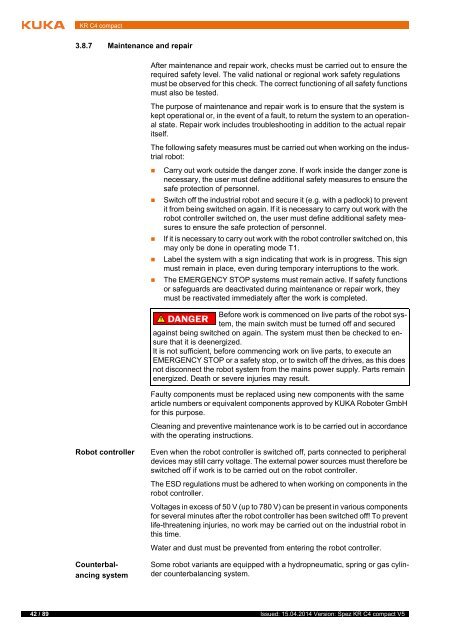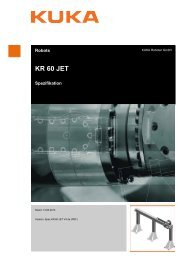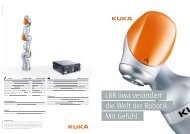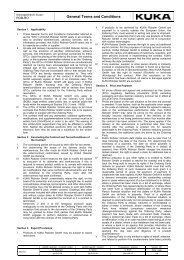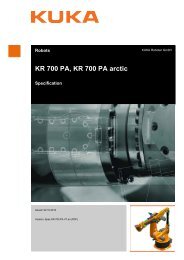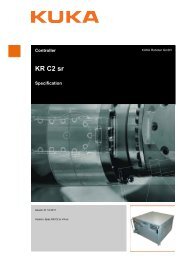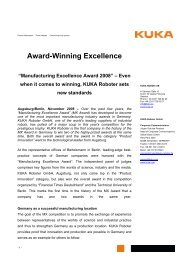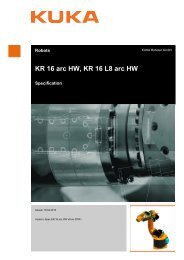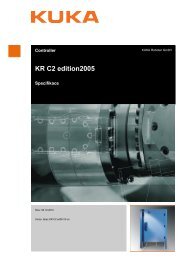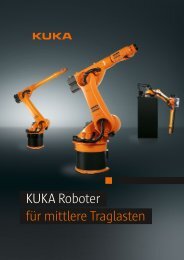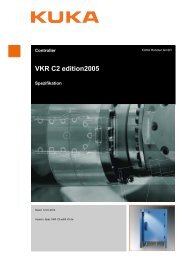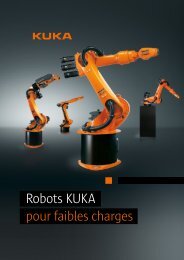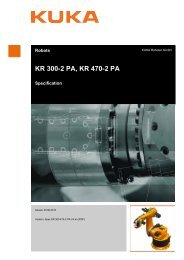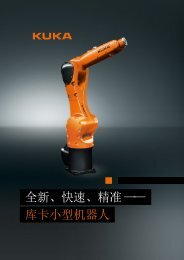KR C4 compact - KUKA Robotics
KR C4 compact - KUKA Robotics
KR C4 compact - KUKA Robotics
You also want an ePaper? Increase the reach of your titles
YUMPU automatically turns print PDFs into web optimized ePapers that Google loves.
<strong>KR</strong> <strong>C4</strong> <strong>compact</strong><br />
3.8.7 Maintenance and repair<br />
After maintenance and repair work, checks must be carried out to ensure the<br />
required safety level. The valid national or regional work safety regulations<br />
must be observed for this check. The correct functioning of all safety functions<br />
must also be tested.<br />
The purpose of maintenance and repair work is to ensure that the system is<br />
kept operational or, in the event of a fault, to return the system to an operational<br />
state. Repair work includes troubleshooting in addition to the actual repair<br />
itself.<br />
The following safety measures must be carried out when working on the industrial<br />
robot:<br />
• Carry out work outside the danger zone. If work inside the danger zone is<br />
necessary, the user must define additional safety measures to ensure the<br />
safe protection of personnel.<br />
• Switch off the industrial robot and secure it (e.g. with a padlock) to prevent<br />
it from being switched on again. If it is necessary to carry out work with the<br />
robot controller switched on, the user must define additional safety measures<br />
to ensure the safe protection of personnel.<br />
• If it is necessary to carry out work with the robot controller switched on, this<br />
may only be done in operating mode T1.<br />
• Label the system with a sign indicating that work is in progress. This sign<br />
must remain in place, even during temporary interruptions to the work.<br />
• The EMERGENCY STOP systems must remain active. If safety functions<br />
or safeguards are deactivated during maintenance or repair work, they<br />
must be reactivated immediately after the work is completed.<br />
Before work is commenced on live parts of the robot system,<br />
the main switch must be turned off and secured<br />
against being switched on again. The system must then be checked to ensure<br />
that it is deenergized.<br />
It is not sufficient, before commencing work on live parts, to execute an<br />
EMERGENCY STOP or a safety stop, or to switch off the drives, as this does<br />
not disconnect the robot system from the mains power supply. Parts remain<br />
energized. Death or severe injuries may result.<br />
Faulty components must be replaced using new components with the same<br />
article numbers or equivalent components approved by <strong>KUKA</strong> Roboter GmbH<br />
for this purpose.<br />
Cleaning and preventive maintenance work is to be carried out in accordance<br />
with the operating instructions.<br />
Robot controller<br />
Counterbalancing<br />
system<br />
Even when the robot controller is switched off, parts connected to peripheral<br />
devices may still carry voltage. The external power sources must therefore be<br />
switched off if work is to be carried out on the robot controller.<br />
The ESD regulations must be adhered to when working on components in the<br />
robot controller.<br />
Voltages in excess of 50 V (up to 780 V) can be present in various components<br />
for several minutes after the robot controller has been switched off! To prevent<br />
life-threatening injuries, no work may be carried out on the industrial robot in<br />
this time.<br />
Water and dust must be prevented from entering the robot controller.<br />
Some robot variants are equipped with a hydropneumatic, spring or gas cylinder<br />
counterbalancing system.<br />
42 / 89 Issued: 15.04.2014 Version: Spez <strong>KR</strong> <strong>C4</strong> <strong>compact</strong> V5


